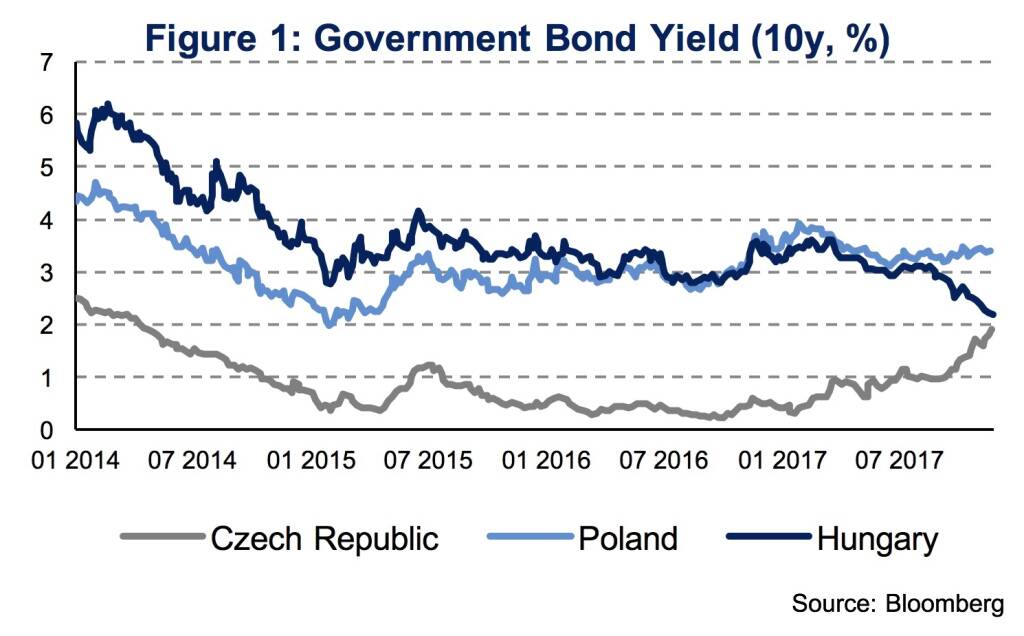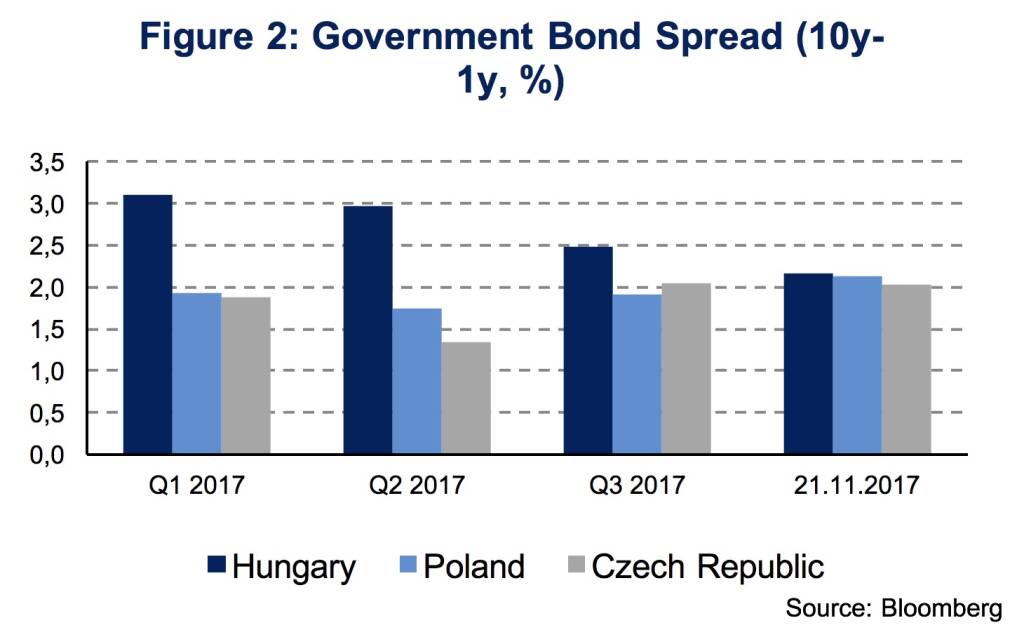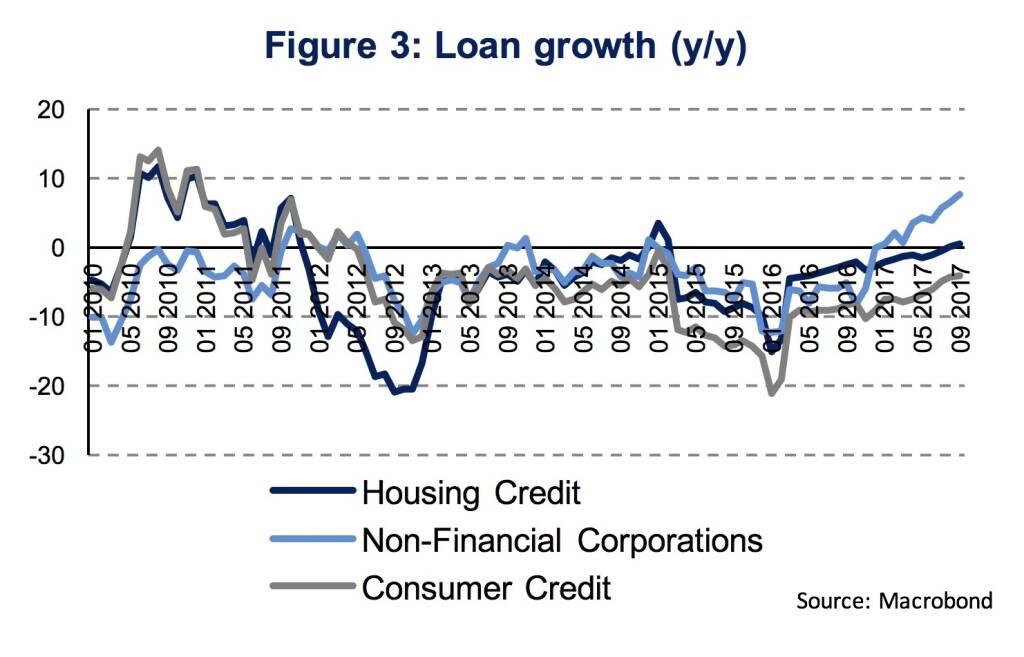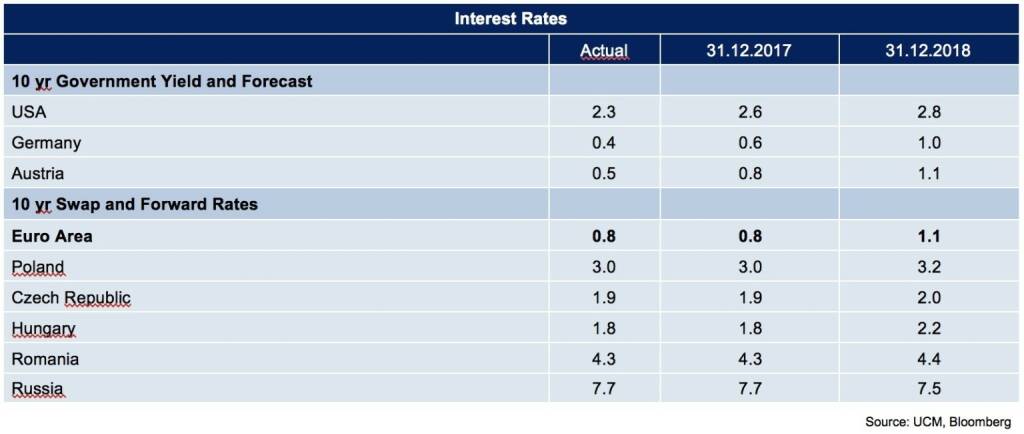CEE: Diverging monetary policy in Hungary (Martin Ertl)
CEE
- Divergence of monetary policy trajectories continues among CE central banks.
- The National Bank of Hungary introduces two unconventional instruments to flatten the yield curve (effective from January 2018) while other CE central banks start with monetary policy normalization.
- New instruments: interest rate swaps (maturities: 5Y and 10Y); purchasing programme of mortgage bonds (maturities: +3Y).
The divergence of monetary policy trajectories among the central banks of the Central European (CE) region continues. The most pronounced difference can be found between the Czech National Bank (CNB) and the National Bank of Hungary (NBH). While the former increased its monetary policy rate (2 week repo rate) by 25 basis points to reach 0.5 % earlier this month, the latter announced the introduction of new non-standard measures to further loosen monetary conditions last week. The National Bank of Poland (NBP) stands between these two by keeping monetary policy unchanged so far, with its governor Glapinski signaling no rate hike until the end of 2018.
According to the NBH’s press release of last week’s monetary council meeting, a further loosening of monetary policy is justified by a weak pass-through of lower short-term rates to longer maturities. Hence, the NBH perceives the yield curve as being too steep. Comparing 10-year government bond yields, as a proxy for the longer end of the yield curve, between selected CE countries shows that Hungarian yields have already declined substantially during recent months (Figure 1). The yield on 10-year Hungarian government bonds is only marginally above the Czech and already well below the Polish counterpart.
Investigating the steepness of the yield curve, by analyzing the spread between government bond yields with maturities of 10 years and 1 year, shows that the Hungarian yield curve was indeed steeper than the Polish or Czech curves for most of 2017. Especially, during the first half of the year the spread was substantially higher. Since the end of September, however, the spread has significantly narrowed showing very similar levels across all three economies (Figure 2). The NBH attributes “the reduction of the overnight deposit rate in September, the introduction of an upper limit on the stock of three-month deposits and central bank communication addressing longer-term yields” for the narrowing of the spread. That the yield curve is still steeper in international comparison can, however, not be supported, at least within the CE region.
Two unconventional instruments, which will become effective in January 2018, are introduced to achieve the objective of lower long-term rates. Their operational details will be released in December. Firstly, the NBH will use unconditional interest rate swap facilities with maturities of 5 and 10 years. The allocation amount has been set at HUF 300 billion for Q1 2018. The NBH was using interest rate swaps with a 10-year maturity during 2015 and 2016 when swaps were offered at an average discount of 44 bp to the market rate until the start of the silent exit period from February 2016. Secondly, a purchasing program targeting mortgage bonds with maturities of 3 years and more, target long term yields and increase the share of mortgage loans with long periods of interest rate fixation. In September the stock of outstanding debt securities issued by resident mortgage banks was 951.5 bn HUF. If the NBH buys 50 % of the outstanding stock, as it indicated, the central bank’s balance sheet will expand by about 475 bn HUF, or 1.3 % of GDP. Even if the NBH’s purchasing program spurs the supply of mortgage bonds, which is likely, the mortgage bond purchasing program cannot be seen as a Fed or ECB like quantitative easing program.
As figure 3 shows, the credit market has already improved with loans expanding mainly in the corporate sector. Nevertheless, the recovery on the credit market is not very advanced yet. Loans to non-financial corporations increased by 6.6 %(y/y) in Q3 2017 after 2.5 % (y/y) in H1 2017. Mortgage loans still stagnated in Q3 and declined by 1.5 % (y/y) during the first half of the year. Consumer loans declined by 4.4 % (y/y) in Q3. Hence, there is some indication that the credit market might depend on more accommodative monetary policy. However, it is worth noting that a decomposition of loans by maturity shows no tendencies that loans of longer maturity are disadvantaged. While mortgage loans at maturities over 5 years are stagnating, the growth of loans to non-financial corporations is driven by loans with maturities over 5 years. Loans to non-financial corporations at a maturity between 1 and 5 years are even still in decline which is questioning the steepness of the yield curve as the main driver for a slow recovery of the credit market.
This in mind it is worth noting that the Hungarian economy is developing dynamically. GDP growth was 3.6 % (y/y, sa) in Q3 2017. Both industrial production (8.1 %, y/y) and retail sales growth (5.9 %, y/y) accelerated in September. Gross wages in September were expanding at double digit rates (13.6 %, y/y) with substantial growth also in the manufacturing sector (11.8 %, y/y). At the same time the unemployment rate has reached a record low of 4.1 %. Nevertheless, the monetary council of the NBH states that “some degree of unused capacity has remained in the economy”. This is in stark contrast to the European Commission’s assessment, which predicts the output gap at 1.5 % of potential GDP in 2017 (AMECO).
Inflation is below the NBH’s 3 % target and even decreased to 2.2 % in October after 2.5 % in September, so did core inflation which declined to 2.7 % in October after 2.9 % in September. Base effects will further negatively influence inflation until the end of 2017. In 2018 it will be seen whether the NBH can still reliably anchor inflation expectations at the 3 % target while gradually reverting to monetary policy normalization. If not, they will have little choice other than to tighten earlier and from a lower level. Our inflation projection sees the 3 % target to be met by the mid of 2018. Forward rates of the 3 months BUBOR imply two 25 bp rate hikes over the next 9 months and three 25 bp rate hikes over the next 12 months.
Authors
Martin Ertl Franz Zobl
Chief Economist Economist
UNIQA Capital Markets GmbH UNIQA Capital Markets GmbH
Disclaimer
This publication is neither a marketing document nor a financial analysis. It merely contains information on general economic data. Despite thorough research and the use of reliable data sources, we cannot be held responsible for the completeness, correctness, currentness or accuracy of the data provided in this publication.
Our analyses are based on public Information, which we consider to be reliable. However, we cannot provide a guarantee that the information is complete or accurate. We reserve the right to change our stated opinion at any time and without prior notice. The provided information in the present publication is not to be understood or used as a recommendation to purchase or sell a financial instrument or alternatively as an invitation to propose an offer. This publication should only be used for information purposes. It cannot replace a bespoke advisory service to an investor based on his / her individual circumstances such as risk appetite, knowledge and experience with financial instruments, investment targets and financial status. The present publication contains short-term market forecasts. Past performance is not a reliable indication for future performance.
Latest Blogs
» SportWoche Podcast #155: Lili Tagger und A...
» Börse-Inputs auf Spotify zu u.a. Ex-Börseh...
» Österreich-Depots: Irre Weekend Bilanz, ab...
» Börsegeschichte 4.4.: Das wird wohl einer ...
» Nachlese: Danke Sophie Wotschke, Rudi Grei...
» Wiener Börse Party #877: Grösster ATX TR-P...
» PIR-News: Pierer Mobility, AMAG, BKS Bank,...
» 618 intraday vs. 605 (Christian Drastil)
» Börse-Inputs auf Spotify zu u.a. gettex-Po...
» Börsepeople im Podcast S18/08: Max Pohanka
Weitere Blogs von Martin Ertl
» Stabilization at a moderate pace (Martin E...
Business and sentiment indicators have stabilized at low levels, a turning point has not yet b...
» USA: The ‘Mid-cycle’ adjustment in key int...
US: The ‘Mid-cycle’ interest rate adjustment is done. The Fed concludes its adj...
» Quarterly Macroeconomic Outlook: Lower gro...
Global economic prospects further weakened as trade disputes remain unsolved. Deceleration has...
» Macroeconomic effects of unconventional mo...
New monetary stimulus package lowers the deposit facility rate to -0.5 % and restarts QE at a ...
» New ECB QE and its effects on interest rat...
The ECB is expected to introduce new unconventional monetary policy measures. First, we cal...




